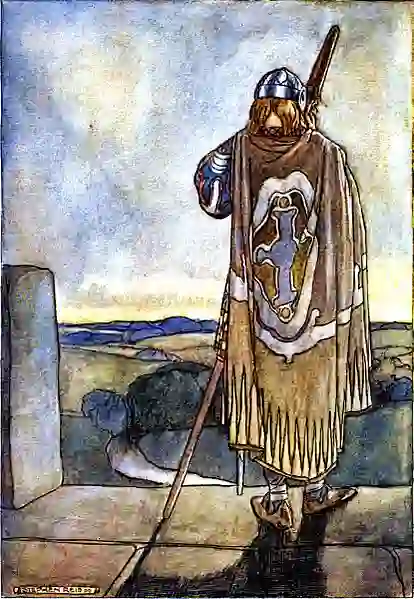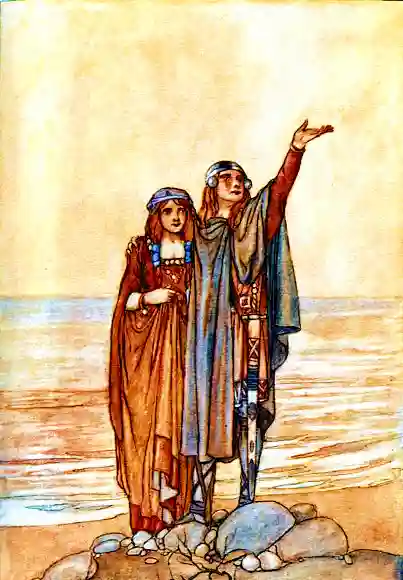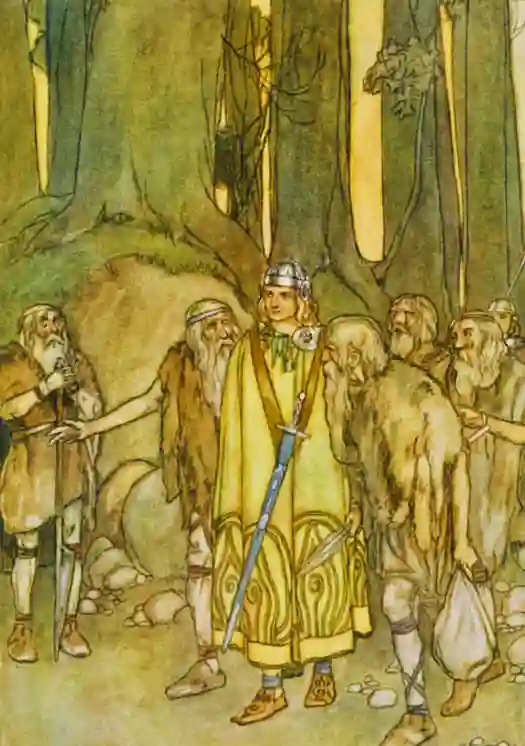The Legend of Finn McCool (Fionn mac Cumhaill)
Fionn mac Cumhaill or Finn McCool is an Irish hero appearing in later Scottish and Manx folklore. He is a mystic, poet, and leader of the Fianna bands of young roving hunter-warriors.
He is said to have a magical thumb that bestows great wisdom on him. He has frequently depicted hunting and fighting with his hounds Bran and Sceólang.
In Scottish legend, Finn MacCool is also known as Fingal. In 1762, a Scottish poet called James Macpherson claimed to have discovered Oisin. Finn’s son published them under several volumes, including Fingal.

Early Childhood of Finn McCool (Fionn mac Cumhaill)
Muireann Muncháem was Fionn’s mother (Muirne). Tadg mac Nuadat, a druid who lived on the hill of Almu, was his maternal grandfather. He had anticipated that her marriage would result in losing his home, so he turned down any potential suitor.
Cumhall, the leader of the feared Fianna warriors who had fallen in love, was forced to abduct her. Outraged, Tadg petitioned the High King of Ireland, Conn of the Hundred Battles, for assistance. Conn agreed and forbade the relationship, dispatching troops to hunt down the newly outlawed Cumhall.
At the Battle of Cnucha, the armies of Conn and Cumhall clashed, and Cath Cnucha Cumhall was killed by Goll Mac Morna (who then became the leader of the Fianna).
King Conn returned Muraine to her father and discovered she was pregnant. Her father, outraged and humiliated, rejected her and ordered his followers to burn her. Conn intervened and instead sent her to Cumhall’s sister, Druidess Bodhmall, and into the care of her husband, Fiacal mac Conchinn.
Muireann became the mother of a son named Deimne. Clearly, the boy’s father Cumhall , still had enemies, so she left her son with Bodhmall in Ballyfin, a small village in Sliabh Bladhma (Slieve Bloom Mountains), Laois, with a heavy heart. Muirne later married Kerry’s king.
Finn was raised in secret by two foster mothers, Bodhmall and her companion Liath Luachra, who were known as great warriors. They hid the boy in the forest, taught him how to be a great warrior, and went on several adventures with him.
Word of young Fionn’s exploits was spreading, and his foster parents were concerned that his father’s enemies would track him down. They had taught him everything they could and sent him to work for local kings, but he was recognized as Cumhall’s son each time.

He was forced to flee again because he was afraid of being unable to protect himself. This nomadic lifestyle appears to have led him south to West Cork to serve the King of Bantry.
Finn McCool grew up in a magical forest surrounded by insane man-eating monsters, learning the arts of war and hunting from his face-melting Druid priestess aunt and her best friend, Liath Luachra.
Finn had many strange adventures growing up, as you might expect from his slightly unconventional childhood. One time, he saw a girl crying bloody tears because a badass Fianna warrior had slain her child, so Finn McCool went out there, snapped the guy in half with his bare hands, and stole all his treasure.
The Appearance of Finn McCool
Finn McCool was a giant warrior, according to Irish legends. His height reached nearly 54 feet, making him a massive creature.
Finn is a nickname that means “fair” (about hair and skin color), “white,” or “bright,” and several legends claim that he got the nickname after his hair turned prematurely white.

Finn McCool and the Story of Wisdom of the Salmon
One of Finn’s most famous stories occurs when he first leaves the forests and mountains of Laois. Fionn met the druid and poet Finnegas when he was young and studied under him for a while.
At the time, Finnegas intended to capture the mythical Salmon of Knowledge from the Boyne River. The legend says that anyone who ate the flesh of this salmon would receive all of the world’s knowledge. With the help of Finn, he managed to capture the salmon, and the young warrior was then asked to cook it for the older man.
Finn is said to have burned his thumb while cooking the salmon. He gained wisdom in the fish by putting the burnt thumb in his mouth to cool it down. Perhaps recognizing Fionn’s destiny for greatness, the druid then gave him the entire fish to eat.
It was widely assumed that Finn could summon the wisdom of the salmon at any time after that by sucking his thumb.

What Happened During Finn McCool’s Wedding with Gráinne
Finn was promised Gráinne, the Irish king’s daughter. On the other hand, his bride was in love with his lieutenant Diarmuid UaDuibhne. The princess got away with Diarmuid on Finn’s wedding night, with Finn and his warriors hot on her tail.
Finn pursued and apprehended the pair, who bravely faced their verdict. Instead of killing them, Finn made peace with the couple after overhearing Gráinne complained to her father about the arranged marriage, and Diarmuid returned to his service.
Finn, on the other hand, could be a vengeful man. When Diarmuid was injured in a boar attack years later, Finn chose to let him die. Finn was said to have miraculous healing powers and could have helped his lieutenant, but instead chose inaction to punish him.
Finn McCool and Sadhabh’s Love Story
Finn met Sadhbh, his most famous wife, while out hunting. Fear Doirich, a druid she had refused to marry, had turned her into a deer.
Finn’s hounds, Bran and Sceólang, who were born of a human enchanted into the form of a hound, recognized her as human and took her home. She reverted to her female form the moment she set foot on Finn’s land, as this was the only place where she could regain her true form.
She and Finn married, and she became pregnant soon after. When Finn was away defending his country, Fear Doirich (literally “Dark Man”) reappeared and transformed her back into a deer, after which she vanished.
Finn searched for her for years with no success. Bran and Sceólang went hunting again and found her son, Oisin, as a fawn; he transformed into a child and became one of the Fianna’s greatest warriors.
The Legendary Battles of Finn McCool (Fionn mac Cumhaill)
According to the Acallam na Senórach, one of Fionn’s feats at the age of ten was to slay Áillen. Áillen is a fire-breathing man of the Tuatha Dé Danann, who had come to wreak destruction on the Irish capital of Tara every year on the festival of Samhain for the past 23 years, lulling the city’s men to sleep with his music before burning down the city and its treasures.
When the King of Ireland asked for volunteers, Fionn volunteered to guard Tara against Áillen’s invasion. Fiacha mac Congha gave Fionn a unique spear (the “Birga”) that warded against the sleep-inducing music of illen’s “dulcimer” when it was unsheathed, and the bare steel blade was touched against the forehead or another part of the body.
This Fiacha had previously served as one of Cumall’s men but was now serving the high king.
After Fionn defeated Áillen and saved Tara, his ancestry was recognized, and he was given command of the Fianna: Goll stepped aside and became a loyal follower of Fionn. However, a dispute between the clans later arose over the pig of Slanga.
Finn McCool not only built the Giant Causeway, but he was also the leader of the Fianna, a group of warriors. The Antrim Coast is the setting for the Causeway story.
It was where Finn lived happily with his wife. His joy, however, began to fade as soon as he learned about Benandonner, his Scottish rival. Finn McCool was constantly teased and insulted by Benandonner.

Finn became irritated by Benandonner’s constant insults one fine day. As a result, he took out a scope of mud and chucked it across the sea to Benandonner. However, he failed, which enraged Finn even more.
On the other hand, the massive swath of dust and mud he hurled ended up in the middle of the Irish Sea. Because the cloud was too large, it formed Lough Neagh after the water filled it up.
Finn McCool, enraged, decided to challenge Benandonner; he decided to confront him with a proper fight in which each party would win or lose. As a result, Finn chose to construct the massive Causeway out of huge stones.
The Causeway was a link between Ireland and Scotland where only the sea stood in the way, but the Causeway triumphed. Finn McCool had the idea to build the Causeway so he could get to Benandonner without getting wet.
The Causeway was ready for Finn McCool to cross, but as he approached the other side, he realized how massive Benandonner was. He was significantly larger than Finn. As a result, he felt a shiver down his spine and fled back to his home.
Finn misplaced one of his massive boots while fleeing. Some claim that the boot still exists, sitting in the exact location where it basically fell off, Port Noffer.
While driving back to his hometown, Finn pondered the best way to defeat Benandonner. Finally, he came up with the idea of hiding, but he wasn’t sure where he could hide without being discovered. He then asked his wife for assistance, asking her to hide him somewhere secretive.
Instead of hiding, his wife devised the strategy of disguise. As a result, the brilliant wife assisted Finn in his disguise as a baby. She cradled him in a huge cradle and pushed him back and forth. She hoped that by doing so, Benandonner would mistake him for a child and continue his search for Finn.

However, the plot took a funny turn. Benandonner noticed the size of the massive cradle one fine day. The size of the sleeping baby surprised him. Benandonner reasoned that a baby of this size must have an equally enormous father.
Benandonner decided to flee back to his house because he was terrified. He was also afraid Finn would follow him, so he destroyed the Causeway on his way home.
Like much mythology, the Finn McCool Story and Giant’s Causeway folklore have been passed down through oral tradition. This means that there are numerous different versions of the story.
In one version of the story, Finn McCool was sleeping in his bed when Oonagh heard the Red Man approaching, so she took it upon herself to hide him.
According to different version of the story, the Giant’s Causeway was never completed. According to the report, McCool and the Red Man never fought because they were both exhausted from building the Causeway and eventually gave up.
The most violent version of the Finn McCool story has McCool wrapped in a sheet biting off Benandonner’s middle finger, causing the Scottish giant to lose all of his strength and flee Ireland forever.
How Did Finn McCool Die?
There are three storylines about how he died. According to legend, He hunted a boar who tried to lead him and his men to the Otherworld. Finn’s death was predicted to happen when he drank from a horn.
In his later years, he attempted to jump across the Boyne River, but after drinking from a horn, he fell into the river and drowned.
According to another legend, Finn McCool was killed by an Athlach with a blow from a fishing gaff. But later, he was avenged by one of his faithful followers, Cailte MacRonain.

According to the last legend, Finn is not dead but is simply sleeping with the Fianna in a cave until the Fianna hunting horn, and the Dord Fiann is sounded three times. Then he will return to defend Ireland in her hour of need.
However, there are several accounts of his death in history. According to the 10th-century poet Cinead ha Hartacáin, Finn was beheaded by Aiclech mac Dubdrenn during the battle against the Lagni Temrach in County Meath.
Conclusion
Finn MacCool, or Fionn mac Cumhaill, is a well-known figure in early Irish folklore. Finn (Fionn) was the leader of the Fianna, a mythical band of Irish warriors who were said to have roamed Ireland around the year 200.
Finn McCool was not only a super genius capable of calculating the rotation of the Earth to the nearest degree per minute by quickly jamming his thumb in his mouth, but he was also a tough-as-nails giant. He stomped balls across the Emerald Isle.
When he grew up, he decided he wanted to restore honor to his family name by proving himself as a face-wrecking destroyer who will take out the brains of anyone foolish enough to stand within three hundred yards of his sword arm.
Finn was well-known for his kindness and wisdom. Because Finn appears in the mythologies of Scotland (often as Fingal) and the Isle of Man, his legend was large enough to cross the sea from Ireland.







